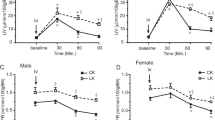Summary
Maleate causes an enhanced excretion of amino acids, glucose, phosphate and bicarbonate. In addition to this inhibition of fluid and electrolyte reabsorption malate decreases glomerular filtration rate (GFR). The present investigation was designed to study the mechanisms of this fall in GFR.
In group I (Sprague-Dawley rats;N=8) maleate (2 mmol/kg body weight i.v.) increased the hydrostatic pressure in proximal tubule from 12.6±0.5 to 16.3±0.8 mm Hg (mean+SEM) and stop flow pressure in the first accessible loop of the proximal tubule was unchanged (33.6±0.4 vs 33.1±1.3 mm Hg; n.s.). Directly measured hydrostatic pressure in the glomerular capillaries in Munich-Wistar rats (N=7), however, was reduced by maleate from 47.6±1.6 to 42.4±1.9 mm Hg. In group II (N=8) we determined single nephron filtration rate (SNGFR) from distal and proximal collection sites in the same nephron in a paired fashion under control conditions and after maleate administration to assess the activity of the tubuloglomerular feedback. In the control periods SNGFR (16 nephrons) from distal collection sites was 26.3±1.6 nl/min whereas SNGFR from proximal collection sites was 31.8±2.4 nl/min. Following maleate distal SNGFR (17 nephrons) was 15.2±1.7 nl/min and proximal SNGFR was 24.3±2.2 nl/min. The ratio distal/proximal SNGFR was 1.23±0.07 under control conditions and increased to 1.76±0.1 following maleate indicating enhanced activity of tubuloglomerular feedback.
Following maleate (group III;N=8) the chloride concentration in the late proximal tubular fluid fell from 135±4 mmol/l to 121±6 mmol/l (13 tubules), however, in the early distal tubule we found an increase in chloride concentration from 43±3 mmol/l to 62±6 mmol/l (12 tubules). Delivery of chloride to the loop of Henle was 2,107±221 pmol/min in the control periods and decreased to 1,475±200 pmol/min during maleate. Since early distal chloride delivery increased from 199±24 pmol/min to 364±47 pmol/min following maleate inhibition of chloride reabsorption in the loop of Henle has to be assumed. We conclude that maleate decreases glomerular filtration rate first by an elevation of hydrostatic pressure in the proximal tubule which is the result of inhibition of fluid and electrolyte reabsorption, and second by activation of the tubuloglomerular feedback.
Similar content being viewed by others
References
Al-Bander HA, Weiss RA, Humphreys MH, Morris Jr. RC (1982) Dysfunction of the proximal tubule underlies maleic acid-induced type II renal tubular acidosis. Am J Physiol 243:F604-F611
Angielski S, Rogulski J (1975) Metabolic studies in experimental renal dysfunction from maleate administration. In: Angielski S, Dubach US (eds) Biochemical aspects of kidney function. Huber, Bern, pp 86–100
Anglielski S, Pempkowiak L, Gmaj P, Hoppe A, Nowicka C (1975) The effect of maleate and lithium on renal function and metabolism. In: Angielski S, Dubach US (eds) Biochemical aspects of kidneys function. Huber, Bern
Berliner RW, Kennedy TJ, Hilton JG (1950) Effect of maleic acid on renal function. Proc Soc Exp Biol Med 75:791–794
Blantz RC, Tucker BJ (1978) Measurements of glomerular dynamics. In: Martinez-Maldonaldo M (ed) Methods in pharmacology, renal pharmacology, vol 4B. New York, pp 141–163
Briggs JP, Wright FS (1979) Feedback control of the glomerular filtration rate: site of effector mechanism. Am J Physiol 236:F40-F47
Briggs JP, Steipe B, Schubert G, Schnermann J (1982) Micropuncture studies of the renal effects of atrial natriuretic substance. Pflügers Arch 395:F271-F276
Davis JM, Schnermann J, Horster M (1972) Micropuncture method for the determination of nephron filtration rate. Pflügers Arch 333:271–280
Gertz KH, Boylan JW (1973) Glomerular-tubular balance. In: Orloff J, Berliner RW (eds) Handbook of physiology, Sec. 8: Renal physiology. Am Phys Soc, Washington
Gmaj P, Nowicka C (1975) Cooperative effects of maleate and Ca on mitochondrial oxidation in the kidney cortex. Proc 5th Colloquium Bioenergetics Mitochondria, Varna
Günter R, Silbernagl S, Deetjen Pf (1979) Maleic acid induced aminoaciduria, studied by free micropuncture and continuous microperfusion. Pflügers Arch 382:109–114
Hermes H (1989) Adenosin als Mediator des tubuloglomerulären Feedbacks in der Niere. Dissertation vorgelegt d. Med. Fakultät d. RWTH, Aachen
Hoppe A, Gmaj P, Metler M, Angielski S (1976) Additive inhibition of renal bicarbonate reabsorption by maleate plus acetazolamide. Am J Physiol 231:1258–1262
Ichikawa I (1982a) Evidence for altered glomerular hemodynamics during acute nephron obstruction. Am J Physiol 242:F580-F585
Ichikawa I (1982b) Direct analysis of the effector mechanism of the tubuloglomerular feedback system. Am J Physiol 243: F447-F455
Osswald H, Evers B, Massmann R, Nabakowski G (1980) Tissue content of adenine nucleotides and adenosine in the rat kidney after administration of maleate. Kidney Int 17:413
Ploth DW, Rudulph J, Thomas C, Navar LG (1978) Renal and tubuloglomerular feedback responses to plasma expansion in the rat. Am J Physiol 235:F156-F162
Ramsay JA, Brown RHJ, Croghan PC (1955) Electrometric titration of chloride in small volumes. J Exp Biol 32:822–829
Rogulski J, Pancanis A (1977) Effects of maleate on CoA metabolism in rat kidney. In: Guder WG, Schmidt H (eds) Biochemical nephrology. Huber, Bern, pp 406–415
Rogulski J, Pacanis A, Strzelecki T, Angielski S (1975) Significance of CoA transferase in the action of maleate on the oxidative metabolism in the kidney. In: Angielski S, Dubach US (eds) Biochemical aspects of kidney function: Huber, Bern
Schnermann J, Wright FS, Davis JM, Stackelberg WV, Grill G (1970) Regulation of superficial nephron filtration rate by tubuloglomerular feedback. Pflügers Arch 318:147–175
Schnermann J, Davis JM, Wunderlich P, Levine DZ, Horster M (1971) Technical problems in the micropuncture determination of nephron filtration rate and their functional implications. Pflügers Arch 329:307–320
Schnermann J, Pearsson AEG, Agerup B (1973) Tubuloglomerular feedback: Non-linear relation between glomerular hydrostatic pressure and loop of Henle perfusion rate. J Clin Invest 52:862–869
Schnermann J, Ploth DW, Hermle M (1976) Activation of tubuloglomerular feedback by chloride transport. Pflügers Arch 362:229–240
Schnermann J, Briggs J, Wright FS (1981) Feedback-mediated reduction of glomerular filtration rate during infusion of hypertonic saline. Kidney Int 20:462–468
Author information
Authors and Affiliations
Rights and permissions
About this article
Cite this article
Leser, K.H., Osswald, H. Maleate induced fall of glomerular filtration rate. Naunyn-Schmiedeberg's Arch. Pharmacol. 331, 253–259 (1985). https://doi.org/10.1007/BF00634246
Received:
Accepted:
Issue Date:
DOI: https://doi.org/10.1007/BF00634246




